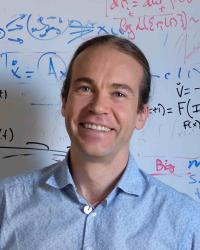
Fields of Interest
Biography
"Eric studied engineering physics at UC-Berkeley and began his research life with a group of wonderful mentors at the Lawrence Livermore National Laboratory, good fortune in this regard that continued in the years to follow. In 2004, he completed his Ph.D in Princeton's Program in Applied and Computational Mathematics, where was advised by Profs. Phil Holmes and Jonathan Cohen at the interface of dynamical systems and neuroscience. His postdoctoral training was with Prof. John Rinzel at NYU's Courant Institute and Center for Neural Science, working on mathematical models in cognitive neuroscience and in the dynamics of neural circuits.
At UW, Eric directs a working group on the dynamics of neural networks and neural populations. These dynamics are beautiful, and are richly varied from setting to setting – at times governed by mechanisms we can distill and explain and at times eluding our best analytical tools. Beyond understanding the nonlinear dynamics of neural circuits, we want to understand how they encode and make decisions about the sensory world. Recent projects are on the time course of decision making in neural networks, mechanisms and consequences of coordinated spike patterns, graph-theoretic tools for cutting neural connectomics problems down to size, and the stability / chaos transition in spiking circuits.
Making progress on these problems requires a range of perspectives and methods. Eric and his group delight in collaboration with fellow theorists of many different backgrounds, and in close ties with with cognitive neuroscientists, biophysicists, and neurophysiologists. These colleagues are developing extraordinary datasets that reveal the brain’s dynamics on a range of scales that would have been unimaginable even a decade ago. As a consequence opportunities for impactful mathematical analysis and modeling currently seem boundless.
Eric’s group works within the creative and expansive neuroscience community at UW, and collaborates closely with Seattle’s Allen Institute for Brain Science, a unique and inspiring institution where he is an affiliate investigator. His work is supported by these crucial connections, and by the Burroughs-Wellcome Fund Scientific Interfaces Program, the Simons Foundation, the NSF, the NIH, the University of Washington Institute for Neural Engineering, and the Center for Sensorimotor Neural Engineering.
(Curriculum vitae...)
Research
Selected Research
- Liu, Y.H., Smith, S., Mihalas S., Shea-Brown E., Sumbul U., “Biologically-plausible backpropagation through arbitrary timespans via local neuromodulators”, Advances in Neural Information Processing Systems, 2022.
- Liu, Y.H., Ghosh A., Richards B. A., Shea-Brown E., Lajoie G., “Beyond accuracy: generalization properties of bio-plausible temporal credit assignment rules”, Advances in Neural Information Processing Systems, 2022. Adviser: Eric T. Shea-Brown
- Liu, Y.H., Smith, S.J., Mihalas S., Shea-Brown E., Sumbul U., “Cell-type–specific neuromodulation guides synaptic credit assignment in a spiking neural network”, Proceedings of the National Academy of Sciences, 2021.Adviser: Eric T. Shea-Brown, Adviser: Stefan Mihalas
Research Advised
- Liu, Y.H., Ghosh A., Richards B. A., Shea-Brown E., Lajoie G., “Beyond accuracy: generalization properties of bio-plausible temporal credit assignment rules”, Advances in Neural Information Processing Systems, 2022.
- Liu, Y.H., Smith, S.J., Mihalas S., Shea-Brown E., Sumbul U., “Cell-type–specific neuromodulation guides synaptic credit assignment in a spiking neural network”, Proceedings of the National Academy of Sciences, 2021.
- Liu, Y.H., Baratin A., Cornford J., Mihalas S., Shea-Brown E., Lajoie G., “How connectivity structure shapes rich and lazy learning in neural circuits”, International Conference on Learning Representations (ICLR), 2024 (accepted).